‘Big lego’: How the largest dinosaur found was brought to Science Centre Singapore
Sign up now: Get ST's newsletters delivered to your inbox
Follow topic:
SINGAPORE – Standing 6m tall and stretching across three badminton courts, Patagotitan mayorum looms, like it would have in life, over smaller life forms carefully manoeuvring around its lumbering heft.
Around 100 million years ago, this Cretaceous behemoth would have roamed the forests of what is known today as Patagonia in South America. It moved on four legs and fed on vegetation that it stripped from branches with the help of its long neck.
Now, it finds itself a long way from home. Aided by scissor lifts and hard-hatted workers, it slowly unfurls its tail in an unfamiliar land.
On the last weekend of September, the world’s largest known dinosaur – roughly eight times the weight of a Tyrannosaurus rex – arrived at Science Centre Singapore. It will spend the next few months in the company of other prehistoric beasts as part of the Dinosaurs | Extinctions | Us showcase, jointly organised by the centre and the NUS Lee Kong Chian Natural History Museum (LKCNHM).
This experience combines two exhibitions: Dinosaurs Of Patagonia, initially curated by Argentina’s Museo Paleontologico Egidio Feruglio, and Six Extinctions, by Gondwana Studios, an Australia-based provider of museum displays.
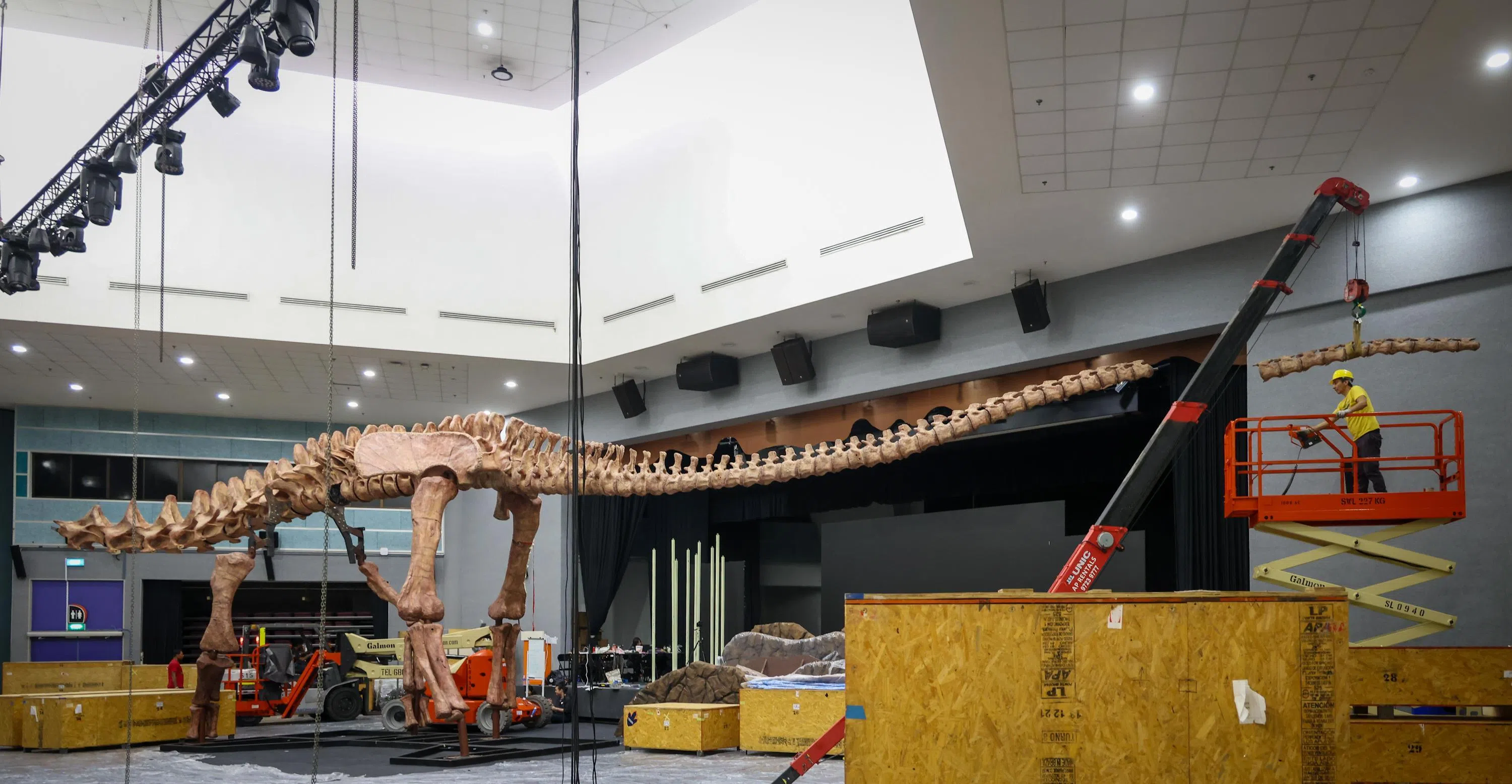
The tail of Patagotitan mayorum being pieced together.
ST PHOTO: JASON QUAH
When it opens on Oct 11, the show will feature 33 rare fossils and 60 full-scale models in an interactive journey that charts the rise and fall of prehistoric life. The Science Centre has not announced an end date for the exhibition.
Assembling the beast
But first, Patagotitan mayorum needs to be pieced back together. A massive operation for a massive beast, the assembly of the cast takes three days and requires the combined effort of five workers and three technicians.
It arrived in sections, having been transported from Argentina to Singapore in two shipping containers.
“Big lego” is how Mr Maximiliano Iberlucea, a senior paleotechnician from Museo Paleontologico Egidio Feruglio in Trelew, Argentina, describes it. The 47-year-old played an active role in the discovery of the sauropod in La Flecha, Argentina, over a decade ago.
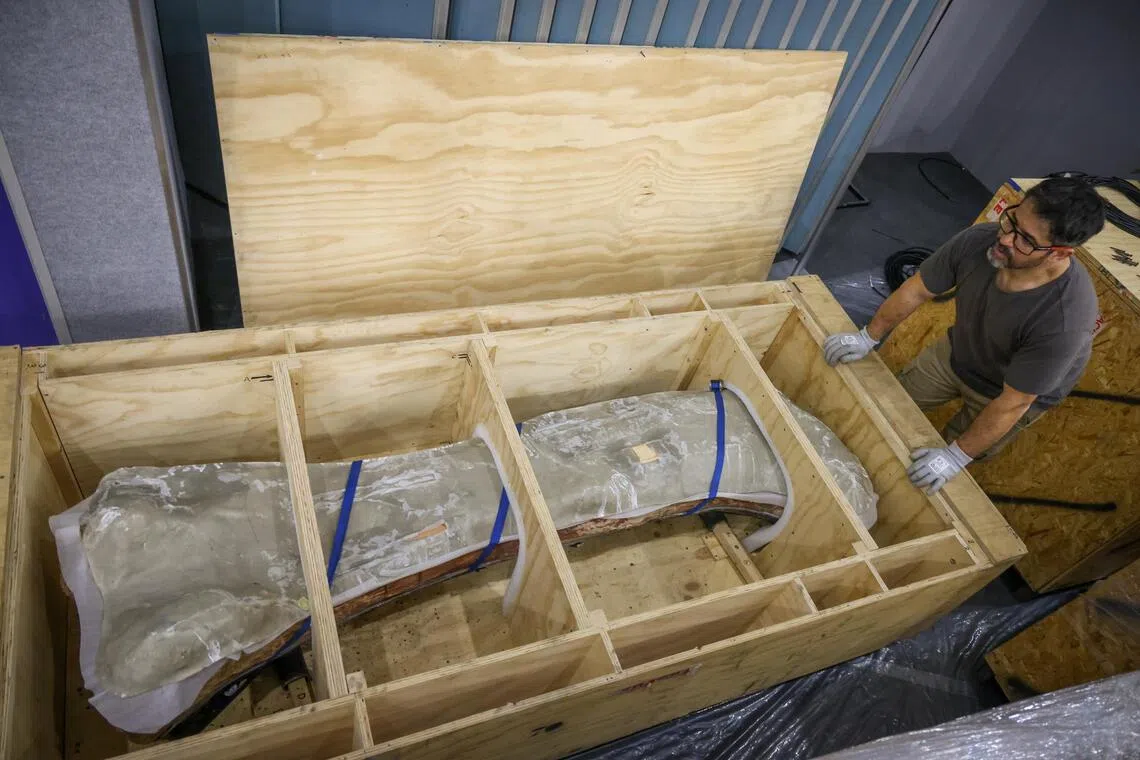
The actual femur of Patagotitan mayorum, which will be on display at the Science Centre.
ST PHOTO: JASON QUAH
It was first spotted in 2010 by a farmer who, while walking his dog, came across an enormous bone sticking out of the ground. He alerted the museum, and over the course of several digs from 2012 to 2015, more than 200 fossils were unearthed, including 130 sauropod bones.
In 2017, scientists grouped these sauropod remains under the type species of a new genus, Patagotitan mayorum, named for Patagonia and the Mayo family, who owned the La Flecha ranch on which it was found.
From the seven specimens that were found, Mr Iberlucea estimates that researchers could complete around 70 per cent of Patagotitan mayorum’s skeleton – a rare feat in the world of palaeontology. The rest was derived by referencing the anatomy of other dinosaurs in the same family, like Titanosaurus.
“For example, if you are missing two or three vertebrae from the neck, you can compare with another dinosaur which has those pieces, and fill the gap. Once the researcher decides how the bone should look, the exhibition department will sculpt it,” he says.
The skeleton on display at the Science Centre is a cast of the actual fossil, made by 3D-scanning the bones and sculpting them from resin, fibreglass, foam and metal. They are then painted to resemble the originals in texture and colour – this Patagotitan mayorum gets its red hue from the sediment in which it was found.
While over 30 pieces of the original fossil, including its 2.38m-long femur, will be on display in Singapore, most of the bones were too heavy to be moved across continents. With its femur alone weighing some 650kg, scientists estimate the whole animal might have tipped the scales at approximately 57 tonnes.
Meanwhile, the cast – in contrast – comes up to a cool 2½ tonnes.
“The bones are very important, and their conservation is our first priority,” says Mr Iberlucea. “They’re unique. If something were to be damaged, we can’t replace it.”
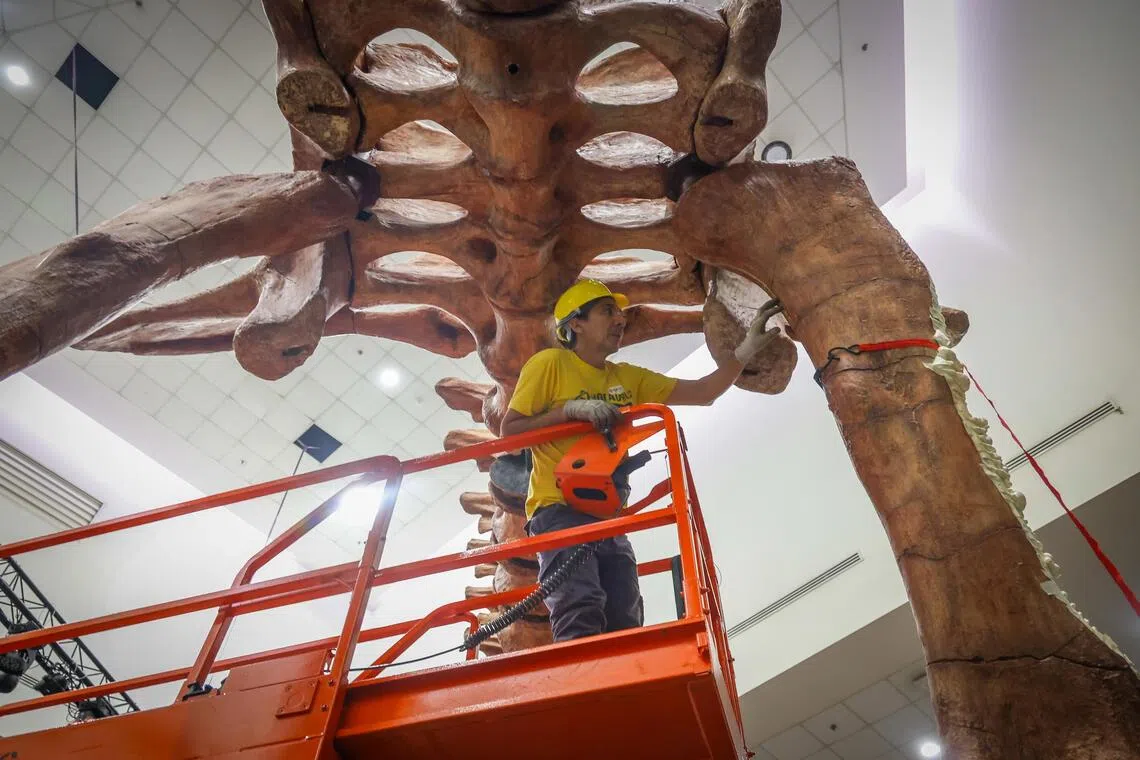
Patagotitan mayorum is the largest dinosaur ever found.
ST PHOTO: JASON QUAH
He adds that mounting the bones in the shape of the dinosaur in motion would have required constructing an external metal structure to support their weight – to avoid piercing the originals with steel rods – which is too risky for these fragile specimens.
Instead, the fossils on display will be laid flat. The femur, in particular, will be mounted on a metal plate, and staff will be stationed around the exhibits to make sure no one gets too close.
“Too much” to fit into one exhibition
Spanning 3,000 sq m of exhibition space, this is the Science Centre’s largest dinosaur showcase, far more vast than the 800 sq m or so its travelling exhibitions usually occupy.
Yet, even with this much room, the team had to navigate the happy problem of how to fit everything they managed to obtain into one exhibition. They were, after all, dealing with a wealth of material from Museo Paleontologico Egidio Feruglio, Gondwana Studios and LKCNHM.
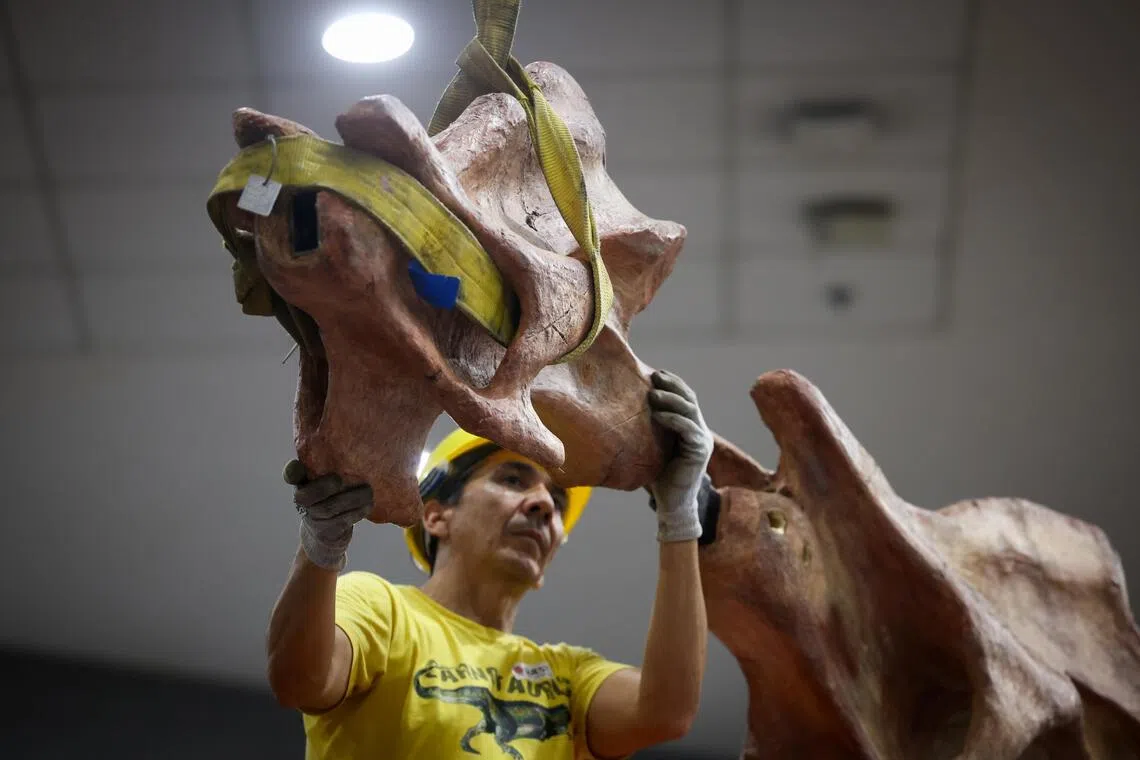
Workers from the Museo Paleontologico Egidio Feruglio were tasked with handling the dinosaur exhibits from Argentina.
ST PHOTO: JASON QUAH
This is the first time the various collections are being fused into one joint show – a move the Science Centre hopes will help them tell a stronger story.
“Most of the time, when you look at a dinosaur exhibition, you are just seeing more and more specimens. But we feel there is an important story we need to bring to Singapore audiences who have been attending dinosaur exhibitions at the Science Centre for many years,” says Mr Daniel Tan, senior director of exhibitions and galleries at Science Centre Singapore.
“This actually brings out a bigger story about biodiversity, about extinction, about geological history. It helps us appreciate how species evolve through time, how long it takes to grow to a certain size, how long it takes to develop a certain feature and, at the same time, how quickly they can all disappear overnight.”
A pertinent message for our times, he adds, with the planet approaching its sixth mass extinction. Some scientists have claimed that human activity like deforestation is wiping out species of plants and animals, with current extinction rates pegged at 100 to 1,000 times higher than natural background extinction rates, according to various estimates.
Here, visitors will get the chance to meet life-size models of extinct animals, like creatures from the Permian, which ruled the earth before the dinosaurs, as well as armoured fish and sabre-toothed beasts.
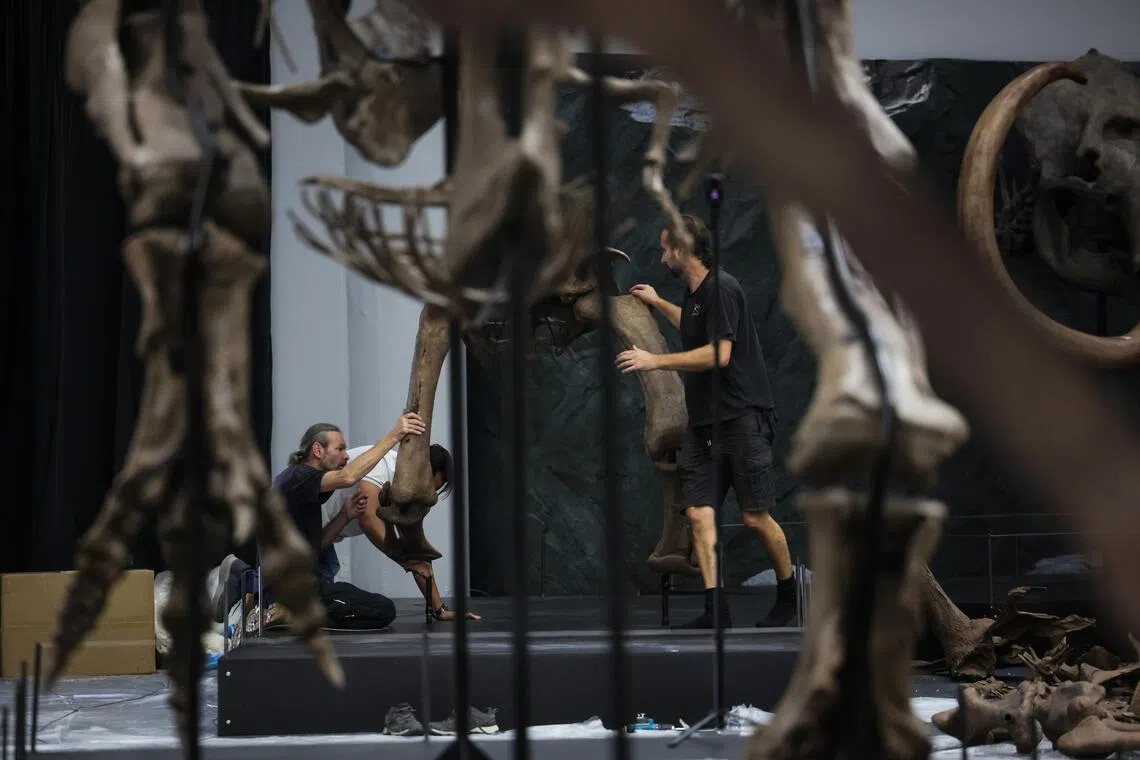
At 3,000 sq m, this is the Science Centre’s largest dinosaur showcase.
ST PHOTO: GIN TAY
To resonate more with local audiences, the exhibition also includes a showcase of seven taxidermied specimens considered locally extinct, courtesy of LKCNHM. It includes animals like the cream-coloured giant squirrel, the rufous-collared kingfisher and the Christmas Island Pipistrelle.
“They are a poignant reminder that extinction still happens despite our best efforts,” says Dr Tan Swee Hee, assistant head senior associate director of LKCNHM.
Though trying to coordinate a show of this scale with partners across the globe has proven logistically tedious – the recent typhoons in Asia have not helped matters, delaying the delivery of a showcase required by LKCNHM – he felt it was important for the museum, which is celebrating its 10th anniversary in 2025, to be a part of this endeavour.
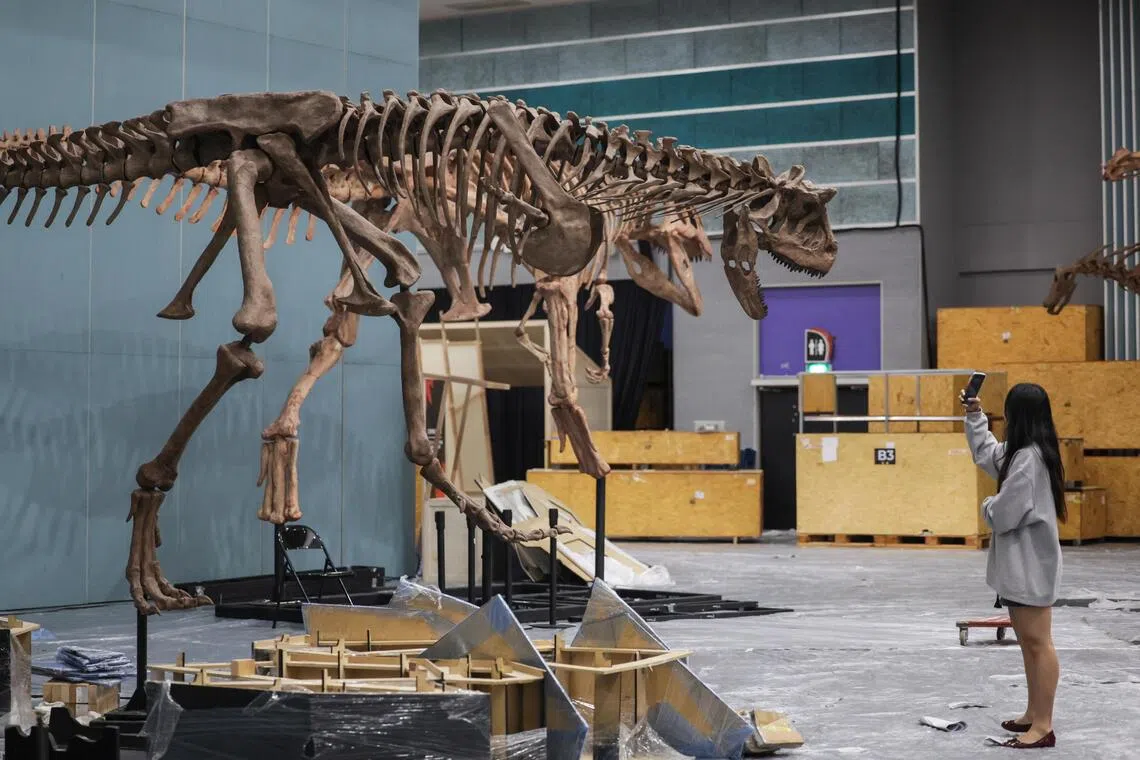
Over 33 rare fossils and 60 full-scale models will be on display.
ST PHOTO: GIN TAY
It last worked with the Science Centre 19 years ago, on another dinosaur exhibition that featured Sue, one of the largest T. rex fossils ever found. Since then, humans’ understanding of dinosaurs has surged and shifted.
“Opinions about what dinosaurs looked like have changed over the past two decades. Now, people think they might have had feathers. There have been revisions on how they could have been related to one another, and more understanding of how these various dinosaurs might have interacted with one another during certain periods. So, it’s an opportunity to present updated information to the public,” says Dr Tan.
A two-hour affair
He is also hoping to leverage the Science Centre’s expertise in repackaging information for visitors of all ages.
“These guys are the experts in organising mass public exhibitions. I’m still learning how to exhibit specimens to the public in the form of interactives. The museum is still quite lacking on that front because we tend to focus a lot on specimen-based displays. I hope by working with the Science Centre, I’ll learn how they find ways to get the public interested in what they’re looking at,” he says.
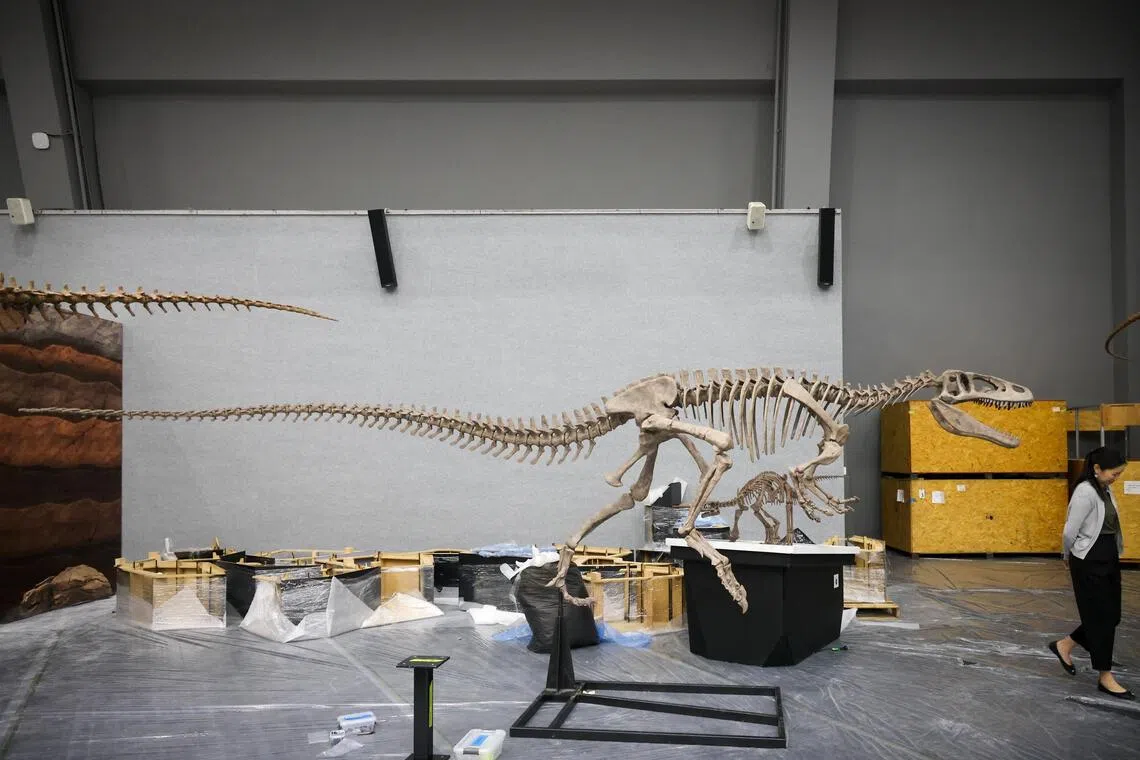
The exhibition will trace how clades like sauropodomorphs evolved.
ST PHOTO: JASON QUAH
As part of this experience, there will be a pit where children can step into the shoes of palaeontologists and dig out “fossils” in the ground. Visitors will also get to design their own dinosaur, learning how researchers deduce the shape of their muscles and colour of their skin in the process.
The show will flow chronologically, taking visitors from the Ordovician period to the late Devonian, Permian, Triassic, Cretaceous and, finally, through the Holocene and Anthropocene.
Along the way, they will get to observe how clades like sauropodomorphs evolved, from small, bipedal omnivores to herbivorous colossi like Patagotitan mayorum.
Other predators will be present to greet them too: a T. rex named Scotty, for one, as well as a Tyrannotitan, whose teeth were found in the same quarry where Patagotitan mayorum was discovered. Here, the former foes are placed across from each other, frozen in an eternal stand-off.
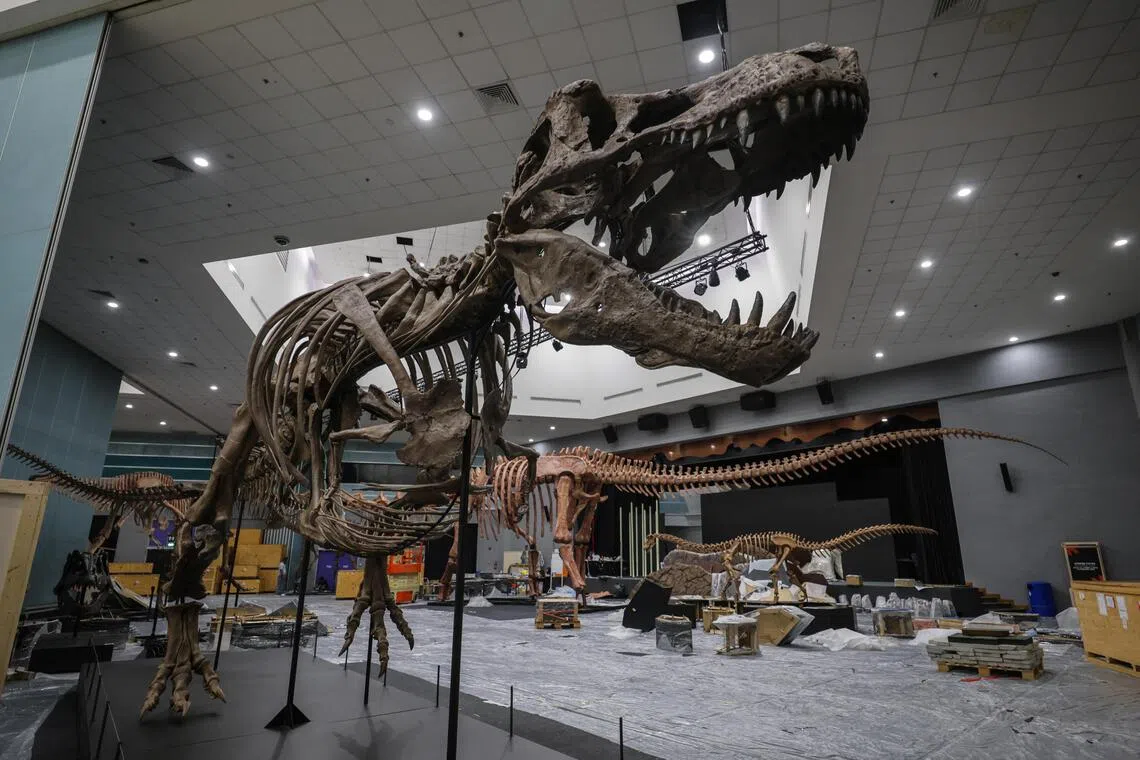
The exhibition also includes a cast of Scotty, the largest T. rex ever discovered.
ST PHOTO: GIN TAY
Lastly, the exhibition will end on a hopeful note. Beyond educating and warning, organisers want to highlight the National Parks Board’s efforts to preserve local biodiversity.
Science Centre’s Mr Tan says: “It comes full circle. We want our audience to come away thinking maybe there are opportunities for them to play a part, so that many of Singapore’s beloved flora and fauna will not become extinct.”
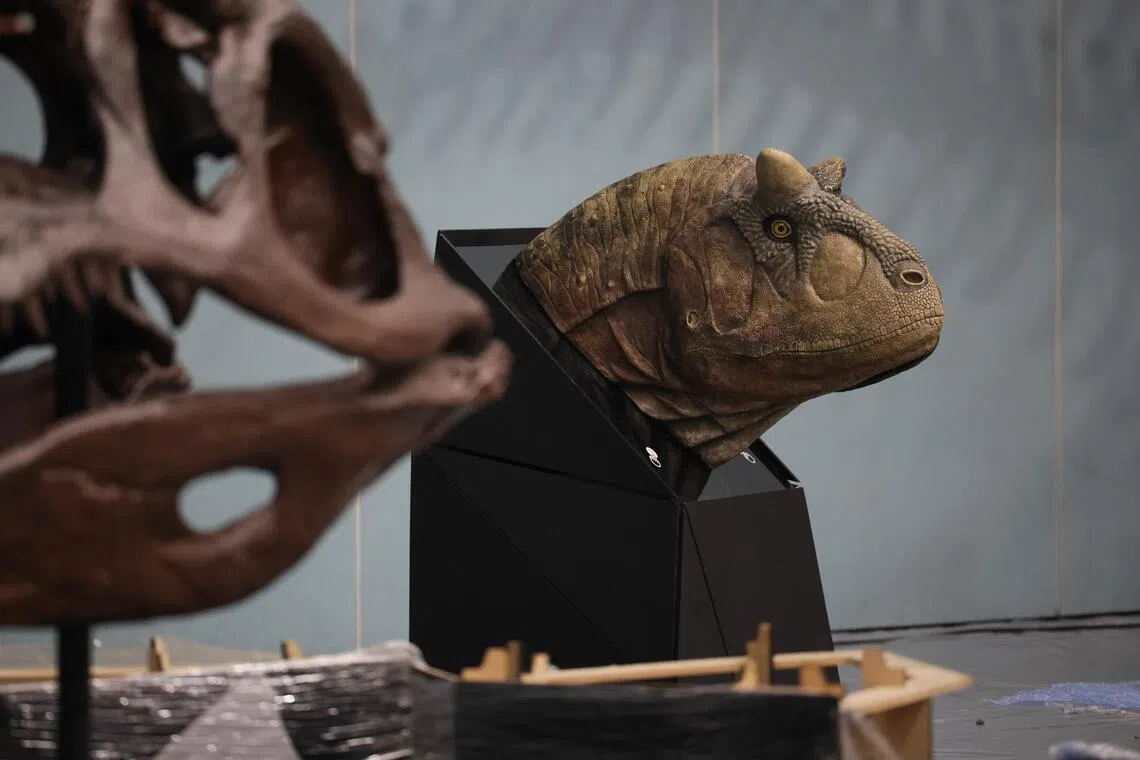
The Science Centre’s Mr Daniel Tan estimates visitors might need two hours or more to appreciate all the models on display.
ST PHOTO: GIN TAY
In all, he estimates that visitors need at least two hours to properly take it all in. Better still if they have half a day to spare.
“It depends on the person,” he says. “But I’m proud to say we haven’t left anything from the respective collections out, so be prepared to be a bit overwhelmed.”
Book It/Dinosaurs | Extinctions | Us
Where: Science Centre Singapore, 15 Science Centre Road str.sg/77e5
Open: From Oct 11, 10am to 5pm (Tuesdays to Sundays)
Admission: Singaporeans and permanent residents, $29.90 (adult), $25.90 (child); standard admission, $39.90 (adult), $35.90 (child)
Info:


